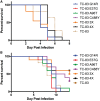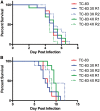Low-fidelity Venezuelan equine encephalitis virus polymerase mutants to improve live-attenuated vaccine safety and efficacy
- PMID: 29593882
- PMCID: PMC5841381
- DOI: 10.1093/ve/vey004
Low-fidelity Venezuelan equine encephalitis virus polymerase mutants to improve live-attenuated vaccine safety and efficacy
Abstract
During RNA virus replication, there is the potential to incorporate mutations that affect virulence or pathogenesis. For live-attenuated vaccines, this has implications for stability, as replication may result in mutations that either restore the wild-type phenotype via reversion or compensate for the attenuating mutations by increasing virulence (pseudoreversion). Recent studies have demonstrated that altering the mutation rate of an RNA virus is an effective attenuation tool. To validate the safety of low-fidelity mutations to increase vaccine attenuation, several mutations in the RNA-dependent RNA-polymerase (RdRp) were tested in the live-attenuated Venezuelan equine encephalitis virus vaccine strain, TC-83. Next generation sequencing after passage in the presence of mutagens revealed a mutant containing three mutations in the RdRp, TC-83 3x, to have decreased replication fidelity, while a second mutant, TC-83 4x displayed no change in fidelity, but shared many phenotypic characteristics with TC-83 3x. Both mutants exhibited increased, albeit inconsistent attenuation in an infant mouse model, as well as increased immunogenicity and complete protection against lethal challenge of an adult murine model compared with the parent TC-83. During serial passaging in a highly permissive model, the mutants increased in virulence but remained less virulent than the parent TC-83. These results suggest that the incorporation of low-fidelity mutations into the RdRp of live-attenuated vaccines for RNA viruses can confer increased immunogenicity whilst showing some evidence of increased attenuation. However, while in theory such constructs may result in more effective vaccines, the instability of the vaccine phenotype decreases the likelihood of this being an effective vaccine strategy.
Keywords: alphavirus; arbovirus; fidelity; vaccine; virus diversity.
Figures







Similar articles
-
Venezuelan Equine Encephalitis Virus V3526 Vaccine RNA-Dependent RNA Polymerase Mutants Increase Vaccine Safety Through Restricted Tissue Tropism in a Murine Model.Zoonoses. 2022;2:2. doi: 10.15212/zoonoses-2021-0016. Epub 2022 Jan 13. Zoonoses. 2022. PMID: 35262074 Free PMC article.
-
Attenuation of human enterovirus 71 high-replication-fidelity variants in AG129 mice.J Virol. 2014 May;88(10):5803-15. doi: 10.1128/JVI.00289-14. Epub 2014 Mar 12. J Virol. 2014. PMID: 24623423 Free PMC article.
-
Polymerase Mechanism-Based Method of Viral Attenuation.Methods Mol Biol. 2016;1349:83-104. doi: 10.1007/978-1-4939-3008-1_6. Methods Mol Biol. 2016. PMID: 26458831 Free PMC article.
-
Viral RNA-dependent RNA polymerase mutants display an altered mutation spectrum resulting in attenuation in both mosquito and vertebrate hosts.PLoS Pathog. 2019 Apr 4;15(4):e1007610. doi: 10.1371/journal.ppat.1007610. eCollection 2019 Apr. PLoS Pathog. 2019. PMID: 30947291 Free PMC article.
-
Phenotypic and genotypic characteristics of Japanese encephalitis attenuated live vaccine virus SA14-14-2 and their stabilities.Vaccine. 2010 May 7;28(21):3635-41. doi: 10.1016/j.vaccine.2010.02.105. Epub 2010 Mar 11. Vaccine. 2010. PMID: 20226891 Review.
Cited by
-
Deep spatial profiling of Venezuelan equine encephalitis virus reveals increased genetic diversity amidst neuroinflammation and cell death during brain infection.J Virol. 2023 Aug 31;97(8):e0082723. doi: 10.1128/jvi.00827-23. Epub 2023 Aug 10. J Virol. 2023. PMID: 37560924 Free PMC article.
-
Advanced Safety and Genetic Stability in Mice of a Novel DNA-Launched Venezuelan Equine Encephalitis Virus Vaccine with Rearranged Structural Genes.Vaccines (Basel). 2020 Mar 2;8(1):114. doi: 10.3390/vaccines8010114. Vaccines (Basel). 2020. PMID: 32121666 Free PMC article.
-
A Low Fidelity Virus Shows Increased Recombination during the Removal of an Alphavirus Reporter Gene.Viruses. 2020 Jun 19;12(6):660. doi: 10.3390/v12060660. Viruses. 2020. PMID: 32575413 Free PMC article.
-
Venezuelan Equine Encephalitis Virus V3526 Vaccine RNA-Dependent RNA Polymerase Mutants Increase Vaccine Safety Through Restricted Tissue Tropism in a Murine Model.Zoonoses. 2022;2:2. doi: 10.15212/zoonoses-2021-0016. Epub 2022 Jan 13. Zoonoses. 2022. PMID: 35262074 Free PMC article.
-
Stabilization of a Broadly Neutralizing Anti-Chikungunya Virus Single Domain Antibody.Front Med (Lausanne). 2021 Jan 28;8:626028. doi: 10.3389/fmed.2021.626028. eCollection 2021. Front Med (Lausanne). 2021. PMID: 33585527 Free PMC article.
References
-
- Alevizatos A. C., McKinney R. W., Feigin R. D. (1967) ‘Live, Attenuated Venezuelan Equine Encephalomyelitis Virus Vaccine’, The American Journal of Tropical. - PubMed
Grants and funding
LinkOut - more resources
Full Text Sources
Other Literature Sources
Research Materials

